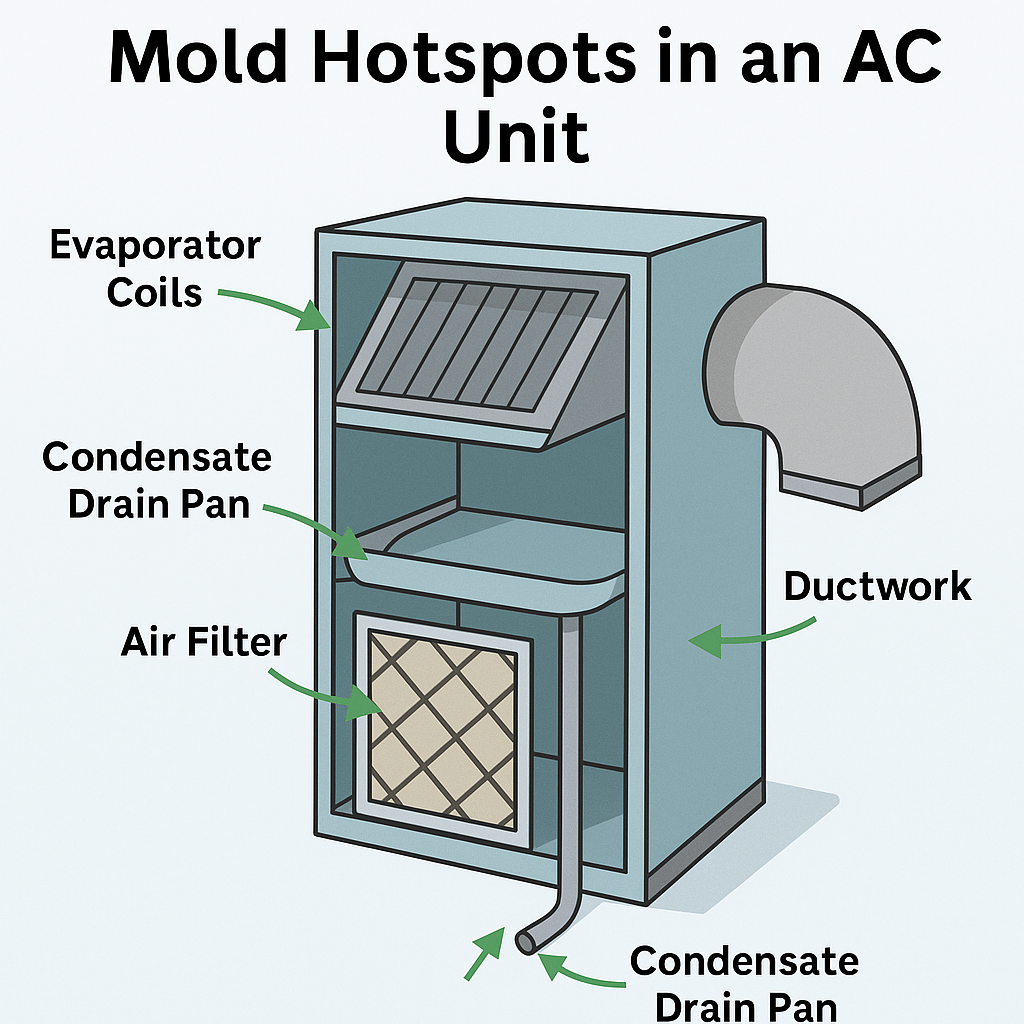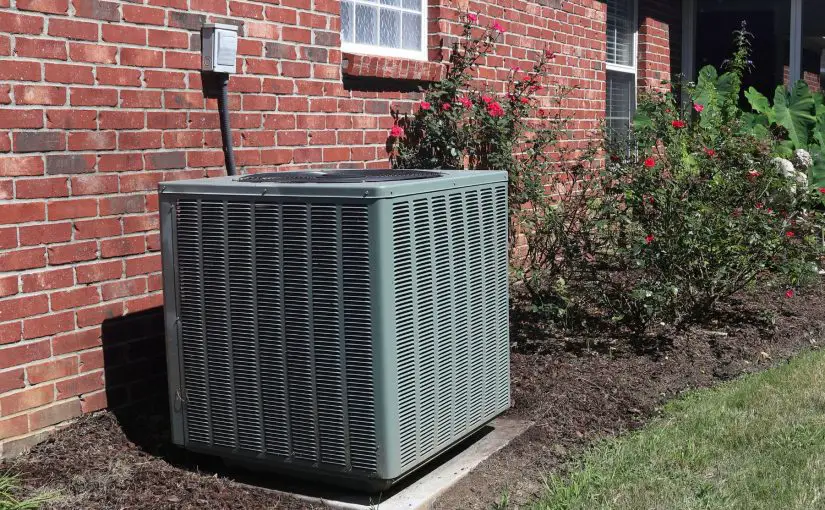Yes — mold can grow inside air conditioning units, and it’s more than just a bad smell.
Moisture, dust, and poor airflow allow spores to multiply, and once they take hold,
mold can circulate through your ducts, reduce system efficiency, and trigger health issues
for both people and pets.

Picture this: you switch on the AC to cool off, but instead of a refreshing breeze,
a musty odor fills the room. That smell is often the first warning sign that mold has
found a home inside your air conditioner. What starts as a little condensation or a clogged
drain can quickly turn your cooling system into a breeding ground for spores that spread
throughout your home.
In this guide, we’ll explain why mold grows in AC units, the health effects you should
know about, and the most effective ways to prevent and remove it — including modern upgrades
like UV lights and induct air purifiers that go beyond basic maintenance.
What Causes Mold to Grow in AC Units?
Mold spores are present everywhere in the environment. When conditions are right, these spores multiply quickly to form mold colonies. The typical conditions that encourage mold growth in air conditioning units include:
- Moisture – High humidity and condensation provide the moisture mold needs to thrive.
- Standing water – Clogged AC drains allow water to pool and stagnate.
- Dust buildup – Dust particles provide a food source for mold.
- Poor airflow – Stagnant air encourages mold growth.
Health Risks of Mold in AC Units
Breathing in mold spores and particles can trigger allergic reactions and asthma symptoms. Other potential health effects include:
- Wheezing, coughing, and chest tightness
- Irritated eyes, nose, throat, and skin
- Headaches, fatigue, and memory problems
- In rare cases, a serious fungal infection in lungs or sinuses
People with asthma, allergies, or compromised immune systems are most vulnerable to the effects of mold. But even healthy people may have reactions after repeated exposure.
 Preventing Mold Growth in AC Units
Preventing Mold Growth in AC Units
Here are some tips to help prevent mold in air conditioners:
-
- Change filters regularly to allow proper airflow.
- Inspect drain lines for clogs and clear them as needed.
- Keep coils and fins free of dust and debris.
- Ensure condensate pans drain properly.
- Seal ductwork to prevent leaks and condensation.
- Install a dehumidifier to control indoor humidity.
- Consider using DampRid, which absorbs excess moisture in air.
Mold Prevention Add‑Ons: UV Lights, Whole‑Home Dehumidifiers & Induct Air Purifiers
Standard maintenance (filters, drains, coil cleaning) keeps mold at bay — but if you’ve had repeat issues
or someone at home is allergy‑sensitive, these upgrades provide continuous, set‑and‑forget protection.
UV Coil Lights
-
-
- What they do: Shine UV‑C on the evaporator coil to sterilize mold and biofilm where they typically form.
- Why it helps: Keeps the coil surface clean between services, preventing musty odors and spore release.
- Good fit for: Homes with past mold growth, high humidity, or long cooling seasons.
-
Whole‑Home Dehumidifiers
-
-
- What they do: Tie into the HVAC to maintain indoor humidity in the 40–50% range consistently.
- Why it helps: Mold needs moisture. Lowering RH makes your entire home less hospitable to growth.
- Good fit for: Humid climates, basements, and homes with condensation issues.
-
 Induct Air Purifiers
Induct Air Purifiers
-
-
- What they do: Install inside ductwork to treat air as it circulates, often using
UV‑C, bipolar ionization, and/or photocatalytic oxidation (PCO). - Why it helps: Targets spores, microbes, and odors before they distribute through supply vents.
- Good fit for: Whole‑home protection vs. room‑by‑room portables; families with allergies/asthma.
- What they do: Install inside ductwork to treat air as it circulates, often using
-
are designed to work without introducing ozone; always check product specifications. See REME HALO
When Sneezing Starts Only When the AC Runs
Mold isn’t always visible. If you get sneezing fits, itchy eyes, or headaches when the AC is on — but feel better
when it’s off — spores may be hitching a ride on airflow from hidden spots like the coil, drain pan, or duct liner.
Early Clues Most People Miss
- On‑again, off‑again symptoms: You feel worse when the AC cycles, better when it rests.
- Musty odor on startup: A brief “dirty sock” smell when the fan kicks on.
- Clean filter, persistent symptoms: Points to growth past the filter (coil/pan/ducts).
Quick Self‑Check
- Inspect the condensate pan and drain for standing water or sludge.
- Shine a light at the evaporator coil (front side) for discoloration or slimy film.
- Look for water stains around the air handler or duct connections.
If symptoms track with AC runtime and you see any of the signs above, address maintenance immediately
(drain clear, coil clean) and consider a UV coil light or induct purifier to stop recurrence.

Can AC Mold Affect Pets?
Yes. Pets can react to moldy air just like people — sometimes more. Watch for sneezing, coughing,
watery eyes, scratching, skin irritation, or “hot spots” that flare up when the AC is running.
Birds are especially sensitive due to delicate respiratory systems.
What to Do if You Suspect AC Mold Is Bothering Your Pet
- Run a deep clean: drain line, pan, and coils; replace the filter.
- Keep indoor humidity in the 40–50% range; use a whole‑home dehumidifier if needed.
- Consider UV coil lights or an induct purifier to reduce spores in circulation.
- Discuss symptoms with your veterinarian, especially for birds or pets with asthma/allergies.
If your dog seems fine outside but starts sneezing when the AC kicks on — or your cat avoids certain rooms —
your HVAC may be spreading spores. Fixing the source protects the whole family.
 Removing Mold from AC Units
Removing Mold from AC Units
If mold is already present, follow these steps for safe removal:
- Turn off and unplug the AC unit.
- Wear gloves, goggles, and a respirator for protection.
- Clean coils and fins with a coil cleaner like Arm & Hammer Coil Cleaner.
- Scrub away surface mold on other components with detergent and water.
- To kill mold, spray a solution of 1 part bleach to 10 parts water.
- Once cleaned, dry all components thoroughly before turning AC back on.
For severe mold contamination, replacement of insulation or other components may be necessary. It’s also a good idea to have HVAC professionals inspect and sanitize ductwork.
Frequently Asked Questions
What are some early signs of mold growth in an AC unit?
Some early signs include musty odors, visible mold growth around vents or filters, increased humidity/condensation, and health symptoms when the AC runs.
Should I have my AC ducts cleaned if there is mold?
Yes, HVAC professionals should thoroughly clean moldy ductwork using vacuuming, brushing, and sanitizing methods.
Can window AC units get mold too?
Yes, mold can grow in window units, especially in the condensate drain area. Follow the same preventive and cleaning steps.
Is it safe to spray bleach directly on AC coils?
Bleach should be diluted 10:1 with water first. Check the manufacturer’s cleaning guidelines before applying any chemicals.
What is the black stuff I see in my AC drain line?
Black substance in drains is usually mold growth, which indicates standing water. Unclog the drain and sanitize to remove it.
Should I replace my AC unit if there is extensive mold?
If mold contamination is severe, replacement may be the best option. An HVAC professional can assess whether the unit can be sufficiently cleaned.
Can poor air quality from AC mold make pets sick too?
Yes, the allergens and toxins from AC mold can also affect pets. It’s best to address the issue promptly.
The Bottom Line
Mold growth is common in air conditioning systems due to the presence of moisture, dust, and condensation. But left unchecked, AC mold can degrade indoor air quality and lead to potential health issues when spores are inhaled. By staying vigilant about maintenance, quickly addressing any mold issues, and having regular professional cleanings, you can help keep your AC system mold-free and your air healthy.


 Preventing Mold Growth in AC Units
Preventing Mold Growth in AC Units

 Removing Mold from AC Units
Removing Mold from AC Units


